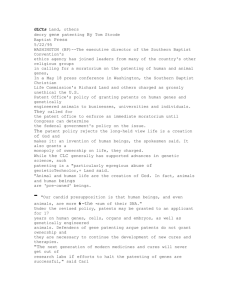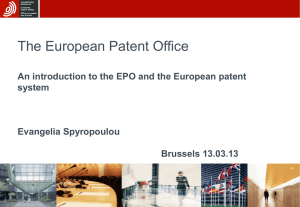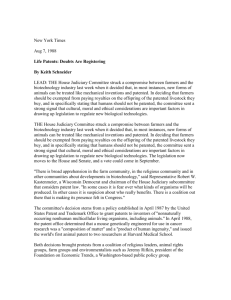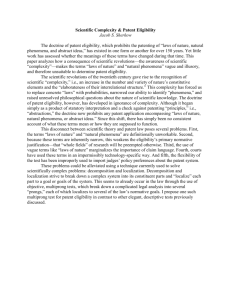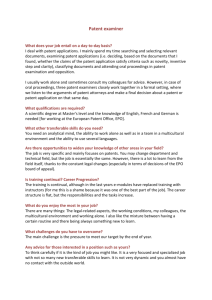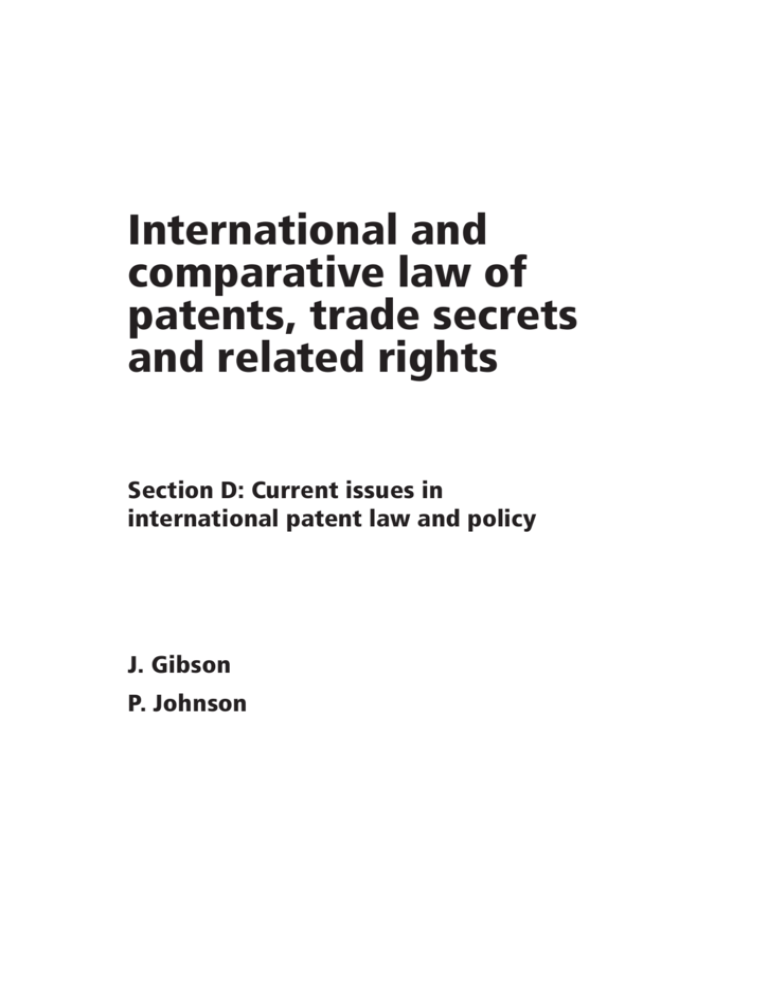
International and
comparative law of
patents, trade secrets
and related rights
Section D: Current issues in
international patent law and policy
J. Gibson
P. Johnson
This Study Guide was prepared for the University of London by:
̆ Johanna Gibson, BA (Hons), MA, PGDipAppSci, JD (Queensland), PhD (Edinburgh)
Solicitor and Barrister to the Supreme Court of Victoria, Herchel Smith Professor of
Intellectual Property Law, Director, Queen Mary Intellectual Property Research Institute.
̆ Phillip Johnson LLB (Hons), LLM, PG Dip (Int Arb), PhD, Attorney (California), Barrister
(England and Wales), Visiting Senior Fellow at the Queen Mary Intellectual Property
Research Institute.
This is one of a series of Study Guides published by the University. We regret that owing to
pressure of work the authors are unable to enter into any correspondence relating to, or
arising from, the Guide.
If you have any comments on this Study Guide, favourable or unfavourable, please use the
form at the back of this Guide.
Publications Office
The External System
University of London
Stewart House
32 Russell Square
London WC1B 5DN
United Kingdom
www.londonexternal.ac.uk
Published by the University of London Press
© University of London 2010
Printed by Central Printing Service, University of London
The University of London does not assert copyright over any readings reproduced in this
publication. However, a separate copyright vests in the format of this work as a published
edition and database rights may exist in its compilation. This copyright and any such database
rights belong to the University of London, as does copyright in the main text. All rights
reserved. No part of this work may be reproduced in any form, or by any means, without
permission in writing from the publisher.
Contents
Contents
Chapter 1: Introduction .......................................................................................... 1
1.1 International and comparative law of patents, trade secrets and related rights .......... 1
1.1.1 Study sequence .............................................................................................. 1
1.2 Introduction to Section D ......................................................................................... 2
1.3 How to use this Study Guide .................................................................................... 3
1.3.1 Reading.......................................................................................................... 4
1.3.2 The eCampus and electronic resources ............................................................ 5
1.3.3 Recent developments...................................................................................... 5
1.3.4 Allocating your time ........................................................................................ 5
1.3.5 The examination ............................................................................................. 5
Chapter 2: Utility models and petty patents .......................................................... 7
2.1 Characteristics of a utility model/petty patent ........................................................... 7
2.2 France ..................................................................................................................... 8
2.3 Germany ................................................................................................................. 8
2.4 European Community .............................................................................................. 8
2.5 Japan ...................................................................................................................... 9
2.6 Australia ................................................................................................................. 9
2.7 United Kingdom .................................................................................................... 10
Chapter 3: The patenting of biological material .................................................. 13
3.1 TRIPS..................................................................................................................... 13
3.2 The Biotechnology Directive ................................................................................... 13
3.2.1 Essentially biological processes ..................................................................... 14
3.2.2 Animal and plant varieties............................................................................. 14
3.2.3 Ordre public ................................................................................................. 14
3.2.4 The patenting of genes ................................................................................. 15
3.2.5 Compulsory licensing .................................................................................... 15
3.2.6 Deposit of biological samples ........................................................................ 15
3.3 The United States .................................................................................................. 15
Chapter 4: Plant variety protection and plant patents ........................................ 17
4.1 The international framework .................................................................................. 17
4.2 The Community regime ......................................................................................... 18
4.3 The US system ....................................................................................................... 19
Chapter 5: Patenting computer software and business methods ........................ 21
5.1 European Patent Convention: the basic problem..................................................... 21
5.1.1 The European Patent Office ........................................................................... 22
5.2 Approach in the United Kingdom ........................................................................... 23
5.3 Approach in the United States................................................................................ 24
Chapter 6: Patent quality...................................................................................... 27
6.1 The substantive law question ................................................................................. 27
6.2 Problems with examination.................................................................................... 28
6.2.1 The information deficit .................................................................................. 28
6.2.2 The role of third parties ................................................................................. 28
6.2.3 Peer-to-patent .............................................................................................. 29
6.2.4 The future ..................................................................................................... 29
i
Chapter 5: Patenting computer software and business methods
Chapter 5: Patenting computer software and
business methods
The patenting of computer software has been one of the most dynamic
and complicated areas in patent law. This is particularly true in Europe
and the United Kingdom. In this chapter you will study the issues that
surround computer programs and, in particular, the often misunderstood
exclusion from protection of computer programs and business methods.
This chapter contrasts the approaches to the subject in the United States,
the European Patent Office and the United Kingdom.
Learning outcomes
Having studied this chapter and the relevant readings, you should be able to:
̆ explain the problems under the European Patent Convention
̆ discuss the developments in the practice of patenting computer software in:
the European Patent Office
the United States
the United Kingdom
̆ outline the history of patenting software from the 1960s until today
̆ discuss the issues surrounding the debates over the patenting of computer software.
Essential reading
̆ Bently and Sherman, pp.405–20
̆ Guadamuz, A. ‘The software patent debate’ (2006) 1 Journal of Intellectual Property
Law and Practice 196.
̆ Lea, G. ‘The revolution that never was: a cynic’s eye view of the software, business
and e-commerce method patenting controversy in the wake of State Street’ 2(1)
Digital Technology Law Journal. Available at: http://www.austlii.edu.au/au/journals/
DTLJ/2000/4.html
̆ Reeve, N. ‘Down to business’ (2007) 2 JIPLP 445.
5.1
European Patent Convention: the basic problem
Both the EPC and the Patents Act 1977 appear, at first blush, to exclude
computer programs from patentability. In the EPC the relevant provision is
Article 52, which reads:
1. European patents shall be granted for any inventions which
are susceptible of industrial application, which are new and
which involve an inventive step.
2. The following in particular shall not be regarded as inventions
within the meaning of paragraph 1
(a) discoveries, scientific theories and mathematical methods;
(b) aesthetic creations;
(c) schemes, rules and methods for performing mental acts,
playing games or doing business, and programs for computers;
(d) presentations of information.
21
International and comparative law of patents, trade secrets and related rights: Section D
3. The provisions of paragraph 2 shall exclude patentability
of the subject-matter or activities referred to in that provision
only to the extent to which a European patent application or
European patent relates to such subject-matter or activities as
such.
The exclusion of computer programs as such is not the only restriction on
patentablity that such things face. In addition, computer programs may
not be patentable because they represent a mathematical method or are
merely a presentation of information. These restrictions are combined
with the problem that certain things might also be a method of doing
business. The rules relating to the exclusion of business methods are
closely linked to the exclusion for computer programs; accordingly, we
will not consider them separately.
There is no clear definition of a ‘computer program’. In Gale’s Application
[1991] RPC 305 the Court of Appeal suggested that it is ‘a sequence
of instructions’ which may be in binary (machine/executable code)
or something closer to natural language (assembly code/high-level
languages).
5.1.1
The European Patent Office
During the 1980s a number of applications were filed for computer
programs, otherwise called computer-implemented inventions. This
ultimately led to the decision in VICOM T-208/84 VICOM [1987] EPOR
74, where it was held that a computer program could be patented where it
involved a technical contribution. The basic approach this advocated was
finding a technical contribution based on the claimed invention against
the known art.
An early example of the technical contribution approach denying an
invention protection was IBM/Text clarity processing [1990] EPOR 606.
In that case it was found that software which simplified the language in a
document was a mental act and so unpatentable. This conclusion was not
affected by using a computer to perform the function.1
In Sohei [1996] EPOR 253 the Technical Board of Appeals began its
departure from the technical contribution approach. Instead, it started
to consider the contribution by reference to the prior art. This approach
re-appeared some time later, but only after the technical contribution
requirement became easier to overcome by reason of the decision in
T0935/97 IBM/Computer Programs [1999] EPOR 301. In that case, the
Board allowed a claim for a computer as programmed because it resulted
in a physical modification of the computer’s hardware when the program
was running. It did not matter that this modification was miniscule in
nature.
Pension Benefit System
The PBS case – Pension Benefit System [2002] EPOR 52 – set out a new
approach to the patentability. The claims were for a method of controlling
a pension benefit program which involved entering certain information,
then processing it and determining the outcomes. The basic method of
doing this was excluded as a business method as such, but the claim
for the product (or apparatus) of a suitably programmed computer was
allowed. This was held because the EPC does not expressly exclude
apparatus under EPC Article 52. This case also confirmed several
important points:
22
1
See also Siemens/
Character Form [1992]
EPOR 69, which was for
a similar invention and
was also rejected.
Chapter 5: Patenting computer software and business methods
̆ A technical invention does not lose its technical character simply because
it is used for a non-technical purpose such as a business method.
̆ A method claim is patentable so long as it is technical.
̆ An apparatus (or product) claim, even if it is a computer as
programmed, cannot be an example of excluded matter since such
things are not mentioned in Article 52(2) of the EPC.
There are now three versions of the hardware approach:
̆ Pension Benefit System. If the claim relates to a method which consists
of excluded subject matter, it is excluded even if hardware is used
to carry out the method. A claim relating to the apparatus (such as
a computer as programmed) is not excluded, but is bad for lack of
inventive step because the notional skilled person must be taken to
know about the improved, excluded method.
̆ T258/03 Hitachi [2005] EPOR 55. A claim to hardware is necessarily
not caught by Article 52(2). A claim to a method using that hardware
is also not within the excluded matter. But either type of claim is bad
for lack of inventive step for the reason described above.
̆ T424/03 Microsoft [2006]. It is proper to ask whether the claim is for
something concrete (like hardware/apparatus). If it is then Article
52(2) does not apply, but inventive step, novelty and so forth should be
applied in the normal way.
These cases demonstrate the desire of the EPO to bypass the exclusions
under Article 52 and to consider only inventive step and novelty. The
correct approach, it has recently been suggested,2 is that something which
is technical falls outside the exclusion, and so what is necessary is to
identify a technical problem.
5.2
In DUNS Licensing
[2006] OJ EPO 46.
2
Approach in the United Kingdom
In the United Kingdom, the law is presently in a state of some flux. In
Aerotel v Telco Holdings [2006] EWCA Civ 1371 it was believed that some
clarity had been brought the field and the correct approach to computer
programs had been identified. In Symbian v Comptroller-General [2008]
EWCA Civ 1066 the Court of Appeal endorsed Aerotel.
Aerotel does not represent a departure from previous UK practice; rather,
it is a return to the earlier decision of the Court of Appeal in Merrill Lynch’s
Application [1989] RPC 561. This decision endorsed the EPO’s decision in
VICOM and introduced the technical contribution requirement to British law.
This technical contribution approach was applied in Gale’s Application [1991]
RPC 305, an application for a method of calculating a square root where the
court held that this was simply a method of doing a mental act. Similarly, in
Fijitsu’s Application [1997] RPC 608 a claim for a method and apparatus for
modelling synthetic crystal structures of inorganic materials was rejected on
the basis that the program was merely a method of displaying an image faster
than could be done with a physical model. Aerotel leaves these decisions in
place and provides a four-step approach to the exclusion:
1.
2.
3.
4.
Properly construe the claim.
Identify the actual contribution.
Ask whether it falls solely within the excluded subject matter.
Check whether the actual or alleged contribution is actually technical
in nature.
23
International and comparative law of patents, trade secrets and related rights: Section D
What was interesting about the approach in Aerotel was that the Court of
Appeal (Jacob LJ in particular) asked the President of the EPO to refer a
question on computer programmes to the Enlarged Board of Appeal. The
question was which of the four approaches of the EPO, as discussed above
in section 5.1.1, was correct. The then President of the EPO believed that
the matter was clear and declined to refer any questions to the Enlarged
Board. Subsequently, following Symbian, the new President of the EPO
referred similar questions to the Enlarged Board and many third parties
have submitted amicus briefs: G 3/08 Computer Programs. This being the
case, the law relating to computer programs remains somewhat dynamic.
Activity 5.1
What is the difference between the patenting of computer software in the United
Kingdom and in the European Patent Office?
Feedback: page 25.
5.3
Approach in the United States
The US courts began, in cases such as Prater & Wei, 415 F. 2d 1378 (1969)
and Bernhart, 417 F. 2d 1395 (1969) by being quite permissive in relation
to the patenting of software-related inventions. This made it clear that
the mental steps doctrine did not automatically preclude software from
patentability. In Gottschalk v Benson, 409 US 63 (1972), however, the
Supreme Court found a patent for an algorithm which transformed binary
coded decimal numbers into pure binary to be invalid. The Court held that
the invention was a sham pre-emption of a mathematical formula and so
was unpatentable.
This decision, however, did not greatly restrict the incidence of computer
software patenting. This decision was followed some years later by Parker
v Flook, 437 US 584 (1978), where the Supreme Court found a computerimplemented invention to be little more than a mathematical formula.
This situation finally changed when the Supreme Court gave judgment
in Diamond v Diehr, 450 US 175 (1981). In that case, a claim for the
implementation of the famous ‘Ahrrenius equation’ for the moulding and
curing of rubber was found to be patentable. The Court of Appeals for
the Federal Circuit reacted over the following years by handing down
a number of decisions on the patentability of software. Notable among
these were Alappat, 33 F 3d 1526 (Fed Cir 1994), where the CAFC
upheld the claim on the basis that it clearly disclosed a machine (albeit a
programmed computer) and so was patentable. This decision was finally
extended to allow ‘pure’ software patents in the infamous State Street
Bank v Signature Finance, 149 F 3d 1368 (Fed Cir 1998).
That case relied on the famous dictum that ‘everything under the sun is
patentable’ to make it clear that computer programs must be patentable.
Accordingly, a computer program only has to satisfy the same rules as any
other invention (novelty, non-obviousness and utility) to obtain a patent.
The State Street decision led to the widespread patenting of software and
business methods, but this has not been welcomed by many groups who
believe that patenting of computer software is harmful to the computer
software industry.
24
Chapter 5: Patenting computer software and business methods
In re Bilski, 545 F 3d 943 (Fed Cir 2008) the liberal approach of
State Street was criticised and the court reiterated the machine or
transformation test. This means that the invention must be either tied to
a particular machine or apparatus, or transform a particular article into a
different state or thing. The case has now been appealed to the Supreme
Court and has attracted many amicus briefs from those interested in the
issue. The decision of the Supreme Court will be significant for patenting
within the United States, but it may also have implications beyond.
Activity 5.2
Do you think the US approach to the patenting of computer software would be well
received in Europe?
No feedback available.
Reminder of learning outcomes
Now that you have studied this chapter and the related readings, you should be able to:
̆ explain the problems under the European Patent Convention
̆ discuss the developments in the practice of patenting computer software in:
the European Patent Office
the United States
the United Kingdom
̆ outline the history of patenting software from the 1960s until today
̆ discuss the issues surrounding the debates over the patenting of computer software.
Self-assessment questions
̆ Which exclusions under Article 52 of the EPC might be relevant to computerimplemented inventions?
̆ How should a claim for a computer-implemented invention be interpreted according
to Aerotel?
̆ In practice do you think the approach of the EPO and the USPTO are the same?
Feedback to activities
Activity 5.1 You should identify the four approaches set out in the Appendix to
the Aerotel decision. You should also mention that the UK still applies the technical
contribution test, but the EPO generally applies a more liberal test based on later cases
such as PBS, Hitachi and Microsoft.
Activity 5.2 No feedback provided.
25

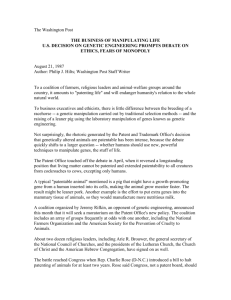
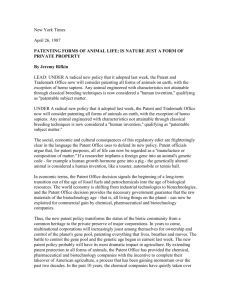
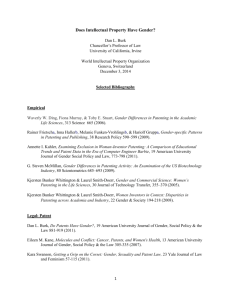
![Introduction [max 1 pg]](http://s3.studylib.net/store/data/007168054_1-d63441680c3a2b0b41ae7f89ed2aefb8-300x300.png)

